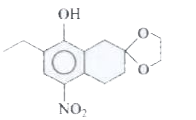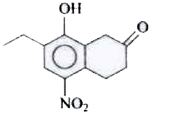Predict the major product of acid catalysed dehydration of
(i) 1-methylcyclohexanol and (ii) butan-1-ol
To predict the major product of acid-catalyzed dehydration of the given alcohols, we will analyze each compound step by step.
Step 1: Understand the Reaction Mechanism
Acid-catalyzed dehydration of alcohols involves the conversion of alcohols into alkenes by removing a water molecule. This typically occurs in the presence of a strong acid, such as sulfuric acid (H₂SO₄). The mechanism includes protonation of the alcohol, formation of a carbocation, and elimination of water.
Step 2: Analyze 1-Methylcyclohexanol
1. Structure: The structure of 1-methylcyclohexanol is as follows:
- A cyclohexane ring with a hydroxyl (OH) group and a methyl (CH₃) group attached to it.
2. Protonation: The hydroxyl group (OH) is protonated by the acid, converting it into a better leaving group (water).
3. Carbocation Formation: After the loss of water, a carbocation is formed. The carbocation can be formed at the carbon where the OH was attached. However, since there is a methyl group on the ring, a 1,2-hydride shift can occur, leading to a more stable secondary carbocation.
4. Elimination: The next step involves the elimination of a proton from a neighboring carbon, leading to the formation of a double bond. The major product will be the more stable alkene formed after the hydride shift.
5. Major Product: The major product from the dehydration of 1-methylcyclohexanol is 1-methylcyclohexene.
Step 3: Analyze Butan-1-ol
1. Structure: Butan-1-ol has the structure CH₃-CH₂-CH₂-CH₂OH.
2. Protonation: Similar to the previous case, the hydroxyl group is protonated to form a better leaving group.
3. Carbocation Formation: The loss of water leads to the formation of a primary carbocation. However, this is not stable, so a 1,2-hydride shift occurs to form a more stable secondary carbocation.
4. Elimination: The secondary carbocation will then lose a proton to form a double bond.
5. Major Product: The major product from the dehydration of butan-1-ol is but-2-ene.
Summary of Major Products
- (i) The major product of the dehydration of 1-methylcyclohexanol is 1-methylcyclohexene.
- (ii) The major product of the dehydration of butan-1-ol is but-2-ene.
Acid-catalyzed dehydration of alcohols involves the conversion of alcohols into alkenes by removing a water molecule. This typically occurs in the presence of a strong acid, such as sulfuric acid (H₂SO₄). The mechanism includes protonation of the alcohol, formation of a carbocation, and elimination of water.
1. Structure: The structure of 1-methylcyclohexanol is as follows:
- A cyclohexane ring with a hydroxyl (OH) group and a methyl (CH₃) group attached to it.
1. Structure: Butan-1-ol has the structure CH₃-CH₂-CH₂-CH₂OH.
- (i) The major product of the dehydration of 1-methylcyclohexanol is 1-methylcyclohexene.
- (ii) The major product of the dehydration of butan-1-ol is but-2-ene.
Similar Questions
Knowledge Check
The major product of acid catalysed dehydration of 2-methylcyclohexanol and butan-1-ol are respectively
A1-methylcyclohexene and but-1-eneB2-methylcyclohexene and but-2-eneC2-methylcyclohexene and butaneD1-methylcyclohexene and but-2-ene.Predict the major product of reaction:
 A
A B
B C
C D
D
Predict the major product of the reaction.
 A
A B
B C
C D
D
Acid catalysed dehydration of 2-pentanol would give
View SolutionPredict the major products of the following reactions:

View SolutionPredict the major product of given reaction :

View SolutionPredict the major product of given reaction :

View SolutionPredict the major product ofthe given reaction.

View Solution

